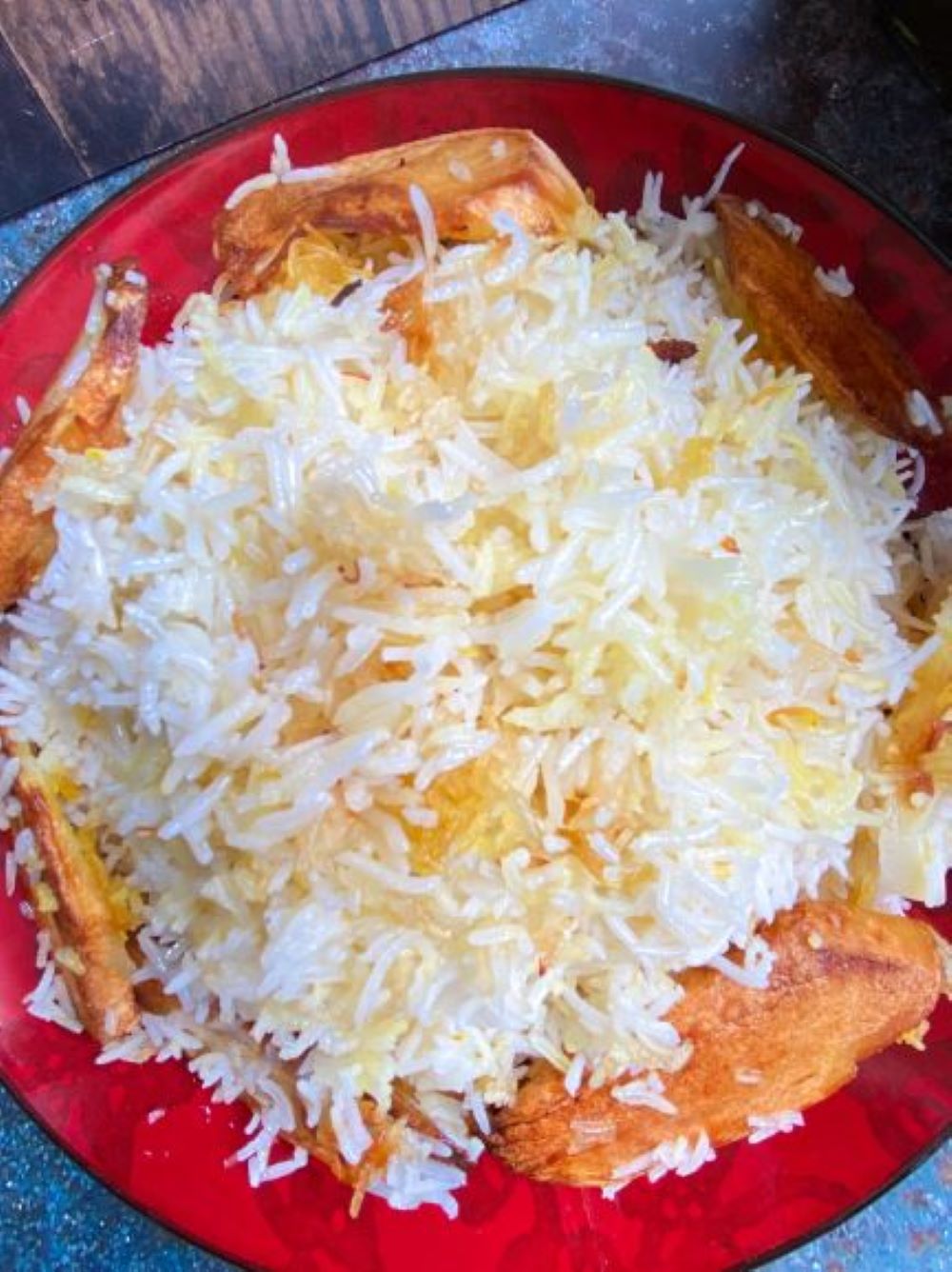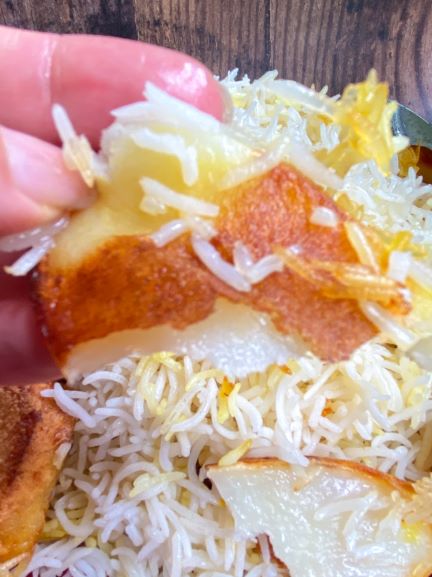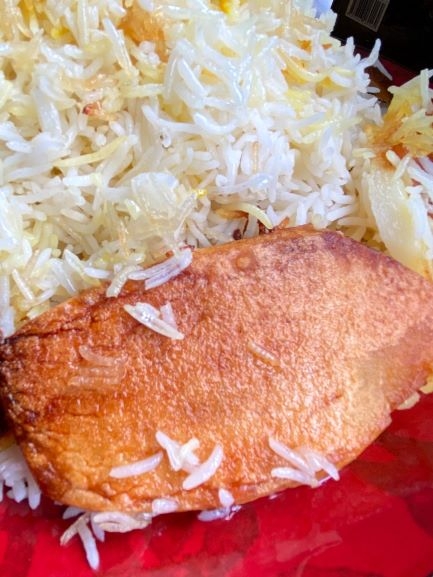When you hear of Persian Rice with Tahdig, only one thing comes to mind- ABSOLUTE DELICIOUSNESS! Persian Rice is long-grained, shiny, mouth-watering, saffron stained grains of rice that look like jeweled rice with pieces of golden and crispy Tahdig (crispy potatoes or rice).
Persian Rice with Tahdig involves a two-step cooking process where the rice is first par-boiled and then steamed to perfection and Tahdig simply means the crispy bottom layer of the rice. You can use rice or potatoes as Tahdig. Some people also use naan as Tahdig.
The credit for this rice goes to the country which is not only famous for its poetry, architecture, plush rugs, and lush gardens but it is also renowned for its rich and luxurious cuisine.
Iran’s cuisine includes a variety of rice dishes and I could write a whole book on it. Baghali Polo (rice cooked with fava beans and dill), Zereshk Polo (barberry rice) are just to name a few. Rice to Iran is what roti is to India. No meal is complete without rice.
Persian Rice is something I grew up eating (almost on a daily basis) and till today it remains one of my favorite rice in the world. A lot of people are intimated by trying to make this rice as it has a few steps but trust me when I tell you this that it is the easiest rice to make and the only thing it requires is love and patience. I will help you demystify this recipe.
What does Chelo mean?
You may have heard of Chelo Kebab or may have seen it on a menu at an Iranian restaurant. Chelo simply means cooked rice and it is traditionaly eaten with kebabs, which is where the name chelo kebab comes from.
What type of rice should you use?
In order to achieve the best results, you should use long grain basmati rice. This is not to say that no other type of rice can be used, but if you are after perfection, then stick to the long grain rice. I personally love Kohinoor long grain basmati rice for its flavor and grains.
Can you make Persian Rice without Saffron?
Yes, you can make this rice without saffron. My mom saved the saffron (as it is extremely expensive) for special occasions and a wow factor! You can achieve the same taste without adding saffron.
Chef’s Suggestions for Perfect Persian Rice
- Use long grain basmati rice
- Use good quality saffron
- Soak the rice for a minimum of 1 hour
- Wash the rice, wash the rice and wash the rice till you have gotten rid of all the starch (this is what causes the rice to be sticky) and are left with clear water to soak the rice in
- Watch the rice when you are par-boiling it and do not walk away from it. It normally takes about 6-7 minutes to bar-boil on medium to high flame. You will know that your rice is ready when it breaks in half but is still uncooked
- Use a nonstick pan when cooking your rice. This will make sure that your Tahdig cooks perfectly and will not stick to the bottom of the pan
- I would highly suggest using clarified butter (ghee) instead of butter or oil. It has a slightly nutty flavor which elevates the taste of this rice
- Try to use Russett potatoes for the Tahdig
- Since the rice is delicate try to use a slotted spatula (see in “My Recommended” products below)
- You can enjoy this rice with anything but it tastes amazing with my
- Ghormeh Sabzi
- Goat Curry
- Seekh Kebabs
- Kubideh (Persian Kebabs)
- Wash the rice 8-10 times in cold water till you have gotten rid of all the starch and soak the rice in clear water for a minimum of 1 hour
- In a mortar and pestle, add in the saffron threads and sugar and grind it to a fine powder. Soak this powder in boiling water and set it aside
TIP: cover it with a plate to increase to intensity of the flavor quickly - To prepare for Tahdig, peel 2 russet potatoes and cut them into 1/4 inch slices and soak them in cold water and set aside
- Bring the 12 cups of water to boil in a large non stick pot
- Add in salt
- Drain the water from the rice and add to boiling water and par boil the rice for 6-7 minutes on medium to high flame
- Drain the rice in a colander and give it a quick rinse with cold water (no more than 3-5 seconds)
- Remove 1/2 cup of bar-boiled rice and mix it with half the saffron liquid and set aside
- Using the same non stick pan, place it back on the stove and add in 3 tablespoons of ghee
- Drain the potatoes from the water and pat dry them using a papertowel
- Layer the bottom of the pot with potatoes and add in rest of the saffron liquid
- Allow the potatoes to cook for 2-3 minutes
- Cover the potatoes with your drained rice
- Add in the rice with saffron liquid on top
- Using the back of your spatula or a spoon, make 3-4 holes in the rice and close the lid
- Cook the rice on medium to high flame for 10 minutes till the Tahdig is formed at the bottom
- Open the lid after 10 minutes and spread the remaining ghee on the sides and middle of the rice, and using a spoon close the holes by covering them with rice
- Top the pot with a clean kitchen towel or paper towel
- Place the lid over the towel and allow the rice to cook on low flame between 25-30 minutes
- After its cooked you can remove the rice and the Tahdig from the bottom of the pan











Your review is awaiting approval
dianabol only cycle results
https://git.the-kn.com/deboral0285287 git.the-kn.com
https://git.siin.space/charlicatalano git.siin.space
https://gitea.zzspider.com/madeleinelemmo gitea.zzspider.com
https://sistemagent.com:8081/jaynewebb58258 sistemagent.com
https://git.ultra.pub/clevelandfethe git.ultra.pub
https://git-web.phomecoming.com/jeffersondown4 https://git-web.phomecoming.com
http://demo.sunflowermachinery.com/terihallman835 http://demo.sunflowermachinery.com/terihallman835
https://omegat.dmu-medical.de/margheritawhit omegat.dmu-medical.de
https://git.nusaerp.com/bettybate78806 git.nusaerp.com
http://9dnakedeye.com.cn:9001/annettbostick 9dnakedeye.com.cn
http://git.yinas.cn/rashadscullin2 git.yinas.cn
https://silatdating.com/@pattibranco968 silatdating.com
https://hgngit.ipdz.me/timmuirden8326 https://hgngit.ipdz.me/timmuirden8326
https://git.dihe.moe/terrysadler27 https://git.dihe.moe
http://git.7doc.com.cn/robbie90y99575 http://git.7doc.com.cn
https://git.avclick.ru/porterknotts89 git.avclick.ru
http://git.fandiyuan.com/jacquesherndon git.fandiyuan.com
https://musixx.smart-und-nett.de/kristan7429901 https://musixx.smart-und-nett.de/kristan7429901
References:
git.cnml.de
Your review is awaiting approval
dianabol oral cycle
https://easyconnect.fun/@mauricepham65 easyconnect.fun
https://www.youtube.com/redirect?q=https://schoolido.lu/user/oboechord7/ http://www.youtube.com
https://hbcustream.com/@numberscabe55?page=about https://hbcustream.com
https://omayaa.com/read-blog/2340_take-a-look-at-and-anavar-cycle-review-dosage-all-test-types.html omayaa.com
http://smandamlg.com/vibe/@spencergalway5?page=about smandamlg.com
https://niceworldeu.com/employer/8-steroids-earlier-than-and-after-picture-and-results-bodybuilding-weblog/ niceworldeu.com
https://socialbookmark.stream/story.php?title=the-center-of-the-internet https://socialbookmark.stream
https://www.fightdynasty.com/companies/anavar-results-after-2-weeks-on-lady-man-before-after/ https://www.fightdynasty.com/companies/anavar-results-after-2-weeks-on-lady-man-before-after/
https://url.jobx.me/naomi04b44903 url.jobx.me
https://hireblitz.com/employer/anavar-for-women-information-up-to-date hireblitz.com
https://gitea.dcqrr.top:83/brendaubs78196 gitea.dcqrr.top
https://git.connectplus.jp/damiend1394307/buying-anavar3623/wiki/Anavar-only+CycleA+easy+cycle+where+users+take+Anavar+alone+for+4-8+weeks+to+maximize+fats+loss+and+muscle+growth.+Women+produce+a+fraction+of+the+extent+of+testosterone+in+comparability+with+males.+Consequently%2C+a+decreased+dosage+of+anabolic+steroids+effectively+replicates+the+identical+degree+of+results+in+ladies+as+in+males.+In+this+cycle+pattern%2C+the+Anavar+dose+of+20+mg%2Fday+is+maintained+for+8+weeks.%7CDrink+a+weight+reduction+cocktail+3+or+4+times+per+day+%E2%80%93+it+is+important+to+not+deviate+from+the+calculated+norm.+A+lady+weighing+70+kg+requires+between+105+and+140+g+of+Oxandrolone.+You+can+always+contact+the+coach+or+a+extra+experienced+athlete+if+you+have+any+questions.+There+are+additionally+on-line+calculators+that+can+tell+you+how+much+Anavar+to+take+for+bodybuilding+while+taking+your+weight+and+activity+level+under+consideration.%7CThis+is+as+a+result+of+Anavar+flushes+extracellular+fluid+out+of+your+physique+which+tends+to+return+again+when+you+cease+taking+it.+Other+than+that%2C+many+of+the+results+that+you+just+obtain+are+going+to+be+there+as+long+as+you+eat+sensibly+and+keep+coaching+hard.+If+you+get+back+to+binge+eating+and+cargo+your+body+with+plenty+of+fat%2C+you+are+not+going+to+keep+the+features.+ACut+is+excellent+for+a+chopping+cycle+and+might+help+you+get+higher+results+from+your+workouts.+Whether+Or+Not+you+want+to+get+ripped+or+form+up+your+abs%2C+ACut+may+help+you+obtain+your+goals+inside+weeks+and+you+can+start+seeing+outcomes+inside+days.%7D.- https://git.connectplus.jp/damiend1394307/buying-anavar3623/wiki/Anavar-only CycleA easy cycle where users take Anavar alone for 4-8
weeks to maximize fats loss and muscle growth. Women produce a fraction of the extent of testosterone in comparability with males.
Consequently, a decreased dosage of anabolic steroids effectively replicates the identical degree of results in ladies as in males.
In this cycle pattern, the Anavar dose of 20 mg/day is maintained for 8 weeks.|Drink a weight reduction cocktail 3 or 4
times per day – it is important to not deviate from the calculated norm.
A lady weighing 70 kg requires between 105 and 140 g of Oxandrolone.
You can always contact the coach or a extra experienced athlete if
you have any questions. There are additionally on-line calculators that can tell
you how much Anavar to take for bodybuilding while taking
your weight and activity level under consideration.|This is as a result of Anavar flushes extracellular fluid out of your physique which tends to return again when you cease taking it.
Other than that, many of the results that you just obtain are going to be there as long as
you eat sensibly and keep coaching hard. If you get back to binge eating and cargo your body with
plenty of fat, you are not going to keep the features.
ACut is excellent for a chopping cycle and might help
you get higher results from your workouts. Whether Or Not you want to get ripped or
form up your abs, ACut may help you obtain your goals inside weeks and you can start
seeing outcomes inside days.}.-
https://slicethis.link/hanna86m596108 slicethis.link
https://vagas.grupooportunityrh.com.br/employer/anavar-results-before-after-pics-of-men-and-women/ https://vagas.grupooportunityrh.com.br/
https://schokigeschmack.de/freddymcness41 schokigeschmack.de
https://gogs.storlead.com/bhkvan93315735 gogs.storlead.com
https://hikvisiondb.webcam/wiki/Anavar_Outcomes_Before_After_Pics_Week_By_Week hikvisiondb.webcam
https://biolink.belfiusolucoes.com.br/stephainemabe4 https://biolink.belfiusolucoes.com.br/stephainemabe4
References:
gitea.ucarmesin.de
Your review is awaiting approval
dianabol deca test cycle
http://www.xiaodingdong.store/home.php?mod=space&uid=2772195 http://www.xiaodingdong.store/home.php?mod=space&uid=2772195
https://git.xn--90acbu5aj5f.xn--p1ai/olivekallas717/7713legal/wiki/Every-Thing-You-Need-To-Know-About-Anavar-Cycles-For-Girls git.90acbu5aj5f.рф
https://code.luoxudong.com/irvin37t439113/irvin2013/wiki/Anavar-Earlier-Than-And-After%3A-Muscle-Gain-Or-Weight-Loss%3F https://code.luoxudong.com
https://gitoad.somestuff.dev/susannahcorso https://gitoad.somestuff.dev/susannahcorso
https://profmustafa.com/@maryjofloyd026?page=about https://profmustafa.com
https://srsbkn.eu.org/walkerdelagarz srsbkn.eu.org
https://jandlfabricating.com/employer/winstrol-anavar-stack-before-and-after-results-and-best-cycle/ jandlfabricating.com
https://git.9ig.com/thedadejesus3 https://git.9ig.com/thedadejesus3
http://www.sg588.tw/home.php?mod=space&uid=1003991 http://www.sg588.tw
https://git.techspec.pro/princeirons442 git.techspec.pro
https://crazyworksports.com/@shawneepidgeon?page=about crazyworksports.com
https://jobflux.eu/employer/251473/rework-your-body-4-week-anavar-cycle-earlier-than-and-after-outcomes-for-females https://jobflux.eu
https://git.aopcloud.com/janellpino121 git.aopcloud.com
https://dexbom.com/chassidybeyers https://dexbom.com
https://social.biblepay.org/read-blog/41144_high-7-testosterone-cycles-the-ultimate-stacking-guide.html social.biblepay.org
https://talentsplendor.com/employer/anavar-oxandrolone-advantages-unwanted-effects-dosage-and-extra/ talentsplendor.com
https://gogs.artapp.cn/grettamatthias gogs.artapp.cn
https://www.google.com.co/url?q=https://portalwe.net/employer/anavar-cycle-mastery-evidence%e2%80%91based-dosing-stack-strategies-and-performance-outcomes/ http://www.google.com.co
References:
muslimlove.com
Your review is awaiting approval
dianabol deca cycle
https://spin.org.pk/employer/anavar-earlier-than-and-after-1-month/ spin.org.pk
https://liixor.site/melinasnider2 liixor.site
https://weneedyou.stepzo.in/companies/39-anavar-cycle-outcomes-that-dissolve-fat-enhance-power-and-harden-your-physique-articles-and-blog/ https://weneedyou.stepzo.in
https://r12imob.store/index.php?page=user&action=pub_profile&id=755920 https://r12imob.store/
https://git.ultra.pub/markoburchett4 https://git.ultra.pub/
https://videos.awaregift.com/@brittnyguardad?page=about videos.awaregift.com
https://icstepup.com/read-blog/7320_anavar-before-and-after-sensible-outcomes-examined-for-health-lovers.html https://icstepup.com
https://kumanets.ru/read-blog/12274_anavar-results-amp-before-and-after-footage-movies.html kumanets.ru
https://chitsime.org/companies/anavar-2019-guide-cycle-dosage-side-effects-and-results/ https://chitsime.org/companies/anavar-2019-guide-cycle-dosage-side-effects-and-results/
http://86bbk.com/home.php?mod=space&uid=245498 http://86bbk.com
https://werkstraat.com/companies/the-brand-new-mr-average/ https://werkstraat.com/
https://thesecurityexchange.com/employer/how-to-take-anavar-for-one-of-the-best-results-guide/ thesecurityexchange.com
https://pad.stuve.uni-ulm.de/JtPf9xhSTSKWjMd0G8uFsw/ https://pad.stuve.uni-ulm.de/
https://home.zhupei.me:3000/katrinsouthwel https://home.zhupei.me
http://mastersrq.online/geraldz317465 http://mastersrq.online/geraldz317465
https://wp.nootheme.com/jobmonster/dummy2/companies/when-to-take-anavar?/ https://wp.nootheme.com
https://git.techspec.pro/piperlau024966 git.techspec.pro
https://gitea.jasonstolle.com/alanarounds774/alana2019/wiki/Anavar+Cycle+Before+%26+After+Outcomes+Review-+Roidzen.- https://gitea.jasonstolle.com/
References:
digitalafterlife.org
Your review is awaiting approval
dianabol deca test cycle
https://www.argfx1.com/user/quitowner20/ beginner
dianabol Cycle
https://www.argfx1.com/user/quitowner20/ dianabol and testosterone cycle for beginners
https://mozillabd.science/wiki/Greatest_Cutting_And_Bulking_Steroids_Buy_Oral_Steroid_Stacks dianabol and testosterone cycle for beginners
https://peatix.com/user/27515711 anavar dianabol cycle
https://graph.org/Dianabol-Methandienone-Bodybuilding-Information-08-09 valley.md
https://molchanovonews.ru/user/rainice6/ dianabol post cycle
https://topspots.cloud/item/403533 valley.md
https://xn—-7sbarohhk4a0dxb3c.xn--p1ai/user/liverscent4/ Valley.md
https://scientific-programs.science/wiki/Dianabol_Cycle_Information_Novices_Results_Charts_Dosage_Length dianabol and testosterone cycle for beginners
https://yogicentral.science/wiki/Dianabol_And_Winstrol_Cycle_Dosage_Benefits_And_Unwanted_Effects dianabol beginner cycle
https://frye-butcher-3.technetbloggers.de/testosterone-cypionate-an-overview dianabol only cycle
https://play.ntop.tv/user/catsupneed4/ dianabol cycle results
https://www.instapaper.com/p/16730143 4 week dianabol cycle
https://newsagg.site/item/402920 dianabol cycle reddit
https://www.samanthaspinelli.it/author/cactusant56/ valley.md
https://mozillabd.science/wiki/Greatest_Cutting_And_Bulking_Steroids_Buy_Oral_Steroid_Stacks valley.Md
https://proxyrate.ru/user/womenfly9/ anavar dianabol cycle
https://personalbookmark.space/item/296128 dianabol and anavar cycle
References:
post cycle Therapy for dianabol (muhammad-ali.com.az)
Your review is awaiting approval
gnc build muscle
References:
zurimeet.com
Your review is awaiting approval
deca dianabol cycle
https://luvwing.com/@yavjulio222385 luvwing.com
https://supardating.com/@tashamartinell https://supardating.com/@tashamartinell
https://git.arachno.de/siobhanfaith98 git.arachno.de
https://gitea.synapsetec.cn/wyattstuart867 gitea.synapsetec.cn
https://music.white-pilled.tv/louellamoten5 https://music.white-pilled.tv/
https://git.cnml.de/luciaw31101543 https://git.cnml.de
http://begild.top:8418/eloisaorme6948 begild.top
https://mp3diary.com/leroyschey3258 mp3diary.com
http://szfinest.com:6060/rhysb622963768 szfinest.com
https://yooverse.com/@ruth4834605617 yooverse.com
https://git.werkraum-karlsruhe.org/susangkn788221 git.werkraum-karlsruhe.org
https://git.arachno.de/siobhanfaith98 git.arachno.de
http://okbestgood.com:3000/steffenmello1 http://okbestgood.com
https://echbar.online/octaviahicks7 https://echbar.online
https://www.musicsound.ca/devinrenwick9 https://www.musicsound.ca/
https://git.bayview.top/minnagarten32 git.bayview.top
https://git.wisptales.org/marquitagauthi git.wisptales.org
https://asixmusik.com/kristoferpolan https://asixmusik.com/kristoferpolan
References:
demo.sunflowermachinery.com
Your review is awaiting approval
ipamorelin sermorelin acetate
References:
https://doc.adminforge.de/YtUncZYdQmqCdsi2qTfO2A
Your review is awaiting approval
can u take creatine while fasting
References:
does creatine build muscle faster (https://play.Ntop.tv)
Your review is awaiting approval
70918248
References:
positive effects of anabolic steroids [happyliving.com.vn]
Your review is awaiting approval
Customers can see important increases in size and power within a short interval, often throughout the first
few weeks of use. Dianabol is typically taken in cycles of
4-6 weeks to cut back the danger of liver pressure,
which is a consideration with this and all oral anabolic steroids.
Testosterone serves as the cornerstone for many steroid cycles, particularly for newbies.
Its reputation is well-earned, as a result of its potent anabolic results and the physique’s pure familiarity with
the hormone. Given its basic position in muscle progress, libido,
and general well-being, it is often the primary alternative for new users.
First-time steroid customers usually start with a moderate dose of testosterone, which might considerably enhance muscle mass and strength.
Variants of testosterone similar to Testosterone Enanthate and Testosterone Cypionate are among the
many most popular forms as a outcome of their longer ester chains,
which indicate less frequent injections.
Transient testosterone suppression is more probably to be average, with levels generally normalizing in a matter of weeks or
months (for most users). Cutting is an important section for a bodybuilder, where the
objective is to burn fats whereas retaining muscle mass gained from the previous bulk.
Dianabol remains to be believed to be the staple bulking steroid in professional bodybuilder stacks right now, 5 decades later.
Combining 5 of our strongest muscle building and fats burning formulation for superb, fast-acting outcomes.
Weight acquire is often minimal to average, depending on goals and diet.
Manufacturing prices are largely accountable, with Halotestin costing roughly 7X as much to
synthesize as testosterone on a mg per mg basis.
This makes it a prime goal for unethical UGL’s and manufacturers concerned solely with revenue.
Each now and then I like to depart from the usually science laden educating fashion which characterizes my writings simply talk about one thing
enjoyable. In truth, it was only a few hours ago, after accidentally coming
across an old Thomas O’Connor article on this very topic, that I was impressed to
pen my own model. This regulatory measure emphasizes the significance of following lawful
and secure protocols when contemplating peptides for enhancing muscle development.
Comparable to 7-KETO DHEA, B-AET doesn’t suppress the HPTA and promotes fats loss by
inhibiting cortisol.
Thus, despite testosterone’s highly effective anabolic nature, it how big can you Get without steroids additionally be
used as a slicing steroid. Dianabol has a major adverse
impact on cholesterol and blood strain, based mostly
on our patient’s blood work. This is due to Dianabol being an oral compound that causes water retention.
These effects are the outcomes of unnaturally
excessive testosterone levels, which may slowly flip a girl into a person. Many elite female bodybuilders are keen to expertise such side effects
so as to win a contest; nonetheless, the general feminine population wants to keep away from these
in any respect costs. We sometimes see testosterone causing only delicate fluctuations in ldl
cholesterol when taken in modest dosages with little hepatic toxicity.
Dianabol, an oral steroid, will stress the
liver, in distinction to Deca-Durabolin, which has no recognized impact on the liver.
If you need to reduce the use of other steroids when on Deca, a low dose of testosterone is usually used.
Even 200mg weekly will go some method to helping with testosterone
levels, however understand that testosterone will include its unwanted facet effects.
A Primobolan-only cycle will produce comparable outcomes to an Anavar-only cycle.
Some ladies could increase their dosage to above 75 mg per day; nonetheless, we discover that going beyond this increases the chance of virilization. Equipoise may be described as a slightly stronger
model of Deca Durabolin and more cost-effective. It is extra androgenic than Deca, resulting in reasonable lean muscle gains and a few fats loss.
Testosterone substitute remedy does not require customers to implement cycles.
However, bodybuilders utilizing supraphysiological doses of testosterone or different anabolic steroids aren’t advised to
take them constantly as a end result of extended toxicity.
Anavar, like Winstrol, is doubtless one of the few oral steroids that can produce lean muscle features whereas concurrently
stripping fat.
Alcohol consumption can increase hepatic strain during steroid cycles.
Moreover, combining oral anabolic steroids with prescribed hepatotoxic medications can cause liver complications.
Trenbolone significantly reduces fats mass whereas facilitating muscle progress.
Bodybuilders additionally make use of trenbolone as a cutting steroid to
speed up fats loss while sustaining muscle on fewer calories.
Anadrol will suppress testosterone ranges, necessitating post-cycle therapy to reestablish regular testosterone perform.
In our experience, failure to employ efficient post-cycle
remedy can lead to gonadal deficiency for a quantity of months or completely if anabolic steroids are
abused.
(typically with very crude, older merchandise; these don’t
exist a lot today) to 25 g. Right Now, nearly all steroids will
fit via a 25 gauge syringe, so this gauge size ought to be your automatic go-to
choice when the viscosity of a steroid is unknown. This gauge is
comparatively thin in comparison to the syringes used again within the day.
Not too long ago the viscosity of many oil-based steroids was a lot larger than it is at present, requiring the use of g.
Needle for mainly each injection…and in some
cases, corresponding to when injecting crude types of Testosterone suspension or injectable Winstrol, an 18 g.
Syringe would be required just to have the power to match the steroid crystals by way of the needle
without clogging it.